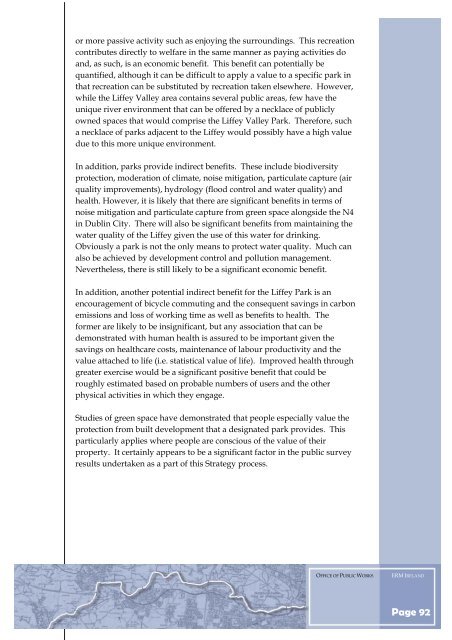Towards a Liffey Valley Strategy Doc. 1 - Kildare.ie
Towards a Liffey Valley Strategy Doc. 1 - Kildare.ie
Towards a Liffey Valley Strategy Doc. 1 - Kildare.ie
You also want an ePaper? Increase the reach of your titles
YUMPU automatically turns print PDFs into web optimized ePapers that Google loves.
or more passive activity such as enjoying the surroundings. This recreation<br />
contributes directly to welfare in the same manner as paying activit<strong>ie</strong>s do<br />
and, as such, is an economic benefit. This benefit can potentially be<br />
quantif<strong>ie</strong>d, although it can be difficult to apply a value to a specific park in<br />
that recreation can be substituted by recreation taken elsewhere. However,<br />
while the <strong>Liffey</strong> <strong>Valley</strong> area contains several public areas, few have the<br />
unique river environment that can be offered by a necklace of publicly<br />
owned spaces that would comprise the <strong>Liffey</strong> <strong>Valley</strong> Park. Therefore, such<br />
a necklace of parks adjacent to the <strong>Liffey</strong> would possibly have a high value<br />
due to this more unique environment.<br />
In addition, parks provide indirect benefits. These include biodiversity<br />
protection, moderation of climate, noise mitigation, particulate capture (air<br />
quality improvements), hydrology (flood control and water quality) and<br />
health. However, it is likely that there are significant benefits in terms of<br />
noise mitigation and particulate capture from green space alongside the N4<br />
in Dublin City. There will also be significant benefits from maintaining the<br />
water quality of the <strong>Liffey</strong> given the use of this water for drinking.<br />
Obviously a park is not the only means to protect water quality. Much can<br />
also be ach<strong>ie</strong>ved by development control and pollution management.<br />
Nevertheless, there is still likely to be a significant economic benefit.<br />
In addition, another potential indirect benefit for the <strong>Liffey</strong> Park is an<br />
encouragement of bicycle commuting and the consequent savings in carbon<br />
emissions and loss of working time as well as benefits to health. The<br />
former are likely to be insignificant, but any association that can be<br />
demonstrated with human health is assured to be important given the<br />
savings on healthcare costs, maintenance of labour productivity and the<br />
value attached to life (i.e. statistical value of life). Improved health through<br />
greater exercise would be a significant positive benefit that could be<br />
roughly estimated based on probable numbers of users and the other<br />
physical activit<strong>ie</strong>s in which they engage.<br />
Stud<strong>ie</strong>s of green space have demonstrated that people especially value the<br />
protection from built development that a designated park provides. This<br />
particularly appl<strong>ie</strong>s where people are conscious of the value of their<br />
property. It certainly appears to be a significant factor in the public survey<br />
results undertaken as a part of this <strong>Strategy</strong> process.<br />
OFFICE OF PUBLIC WORKS ERM IRELAND<br />
Page 92
















